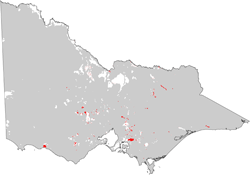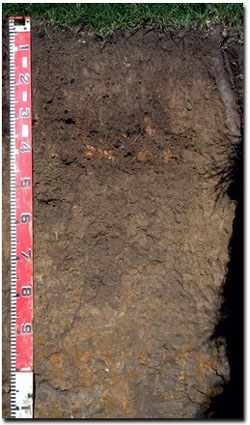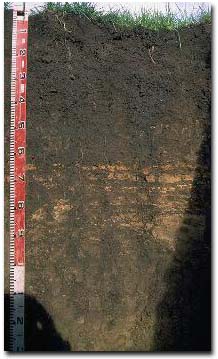Victorian Horticulture Soils - Demosols
Back to: Victorian Horticulture Soils
Dermosols are structured soils that lack strong texture contrast between surface (A) horizons and subsoil (B) horizons.
Distribution
| In West Gippsland, Acidic Brown and Grey mottled Dermosols have developed on the strongly dissected rolling hills of the Strzelecki Ranges. They are characterised by a lack of strong texture contrast, and are strongly acid throughout the profile. Weathered Cretaceous sandstone and mudstone usually occurs before 1.5 metre depth. Similar soils are also common on many of the steep slopes of the Otway Ranges. Soil Pit Site SG12 is an example of a Brown Dermosol near Fish Creek North. |  |
| Black Dermosols have developed on more recent alluvial sediments associated with the Thomson, Macalister and Avon floodplains. They lack strong texture contrast and are very strongly structured and permeable. Black Dermosols with subsurface peaty layers have also developed in former swamp deposits to the north and east of Koo Wee Rup. Soil Pit Site GP73 is an example of a Black Dermosol near Maffra. Black and dark Grey Dermosols with subsurface peaty layers have also developed in former swamp deposits to the north and east of Koo Wee Rup. Soil Pit Site GP26 is an example of a dark Grey Dermosol near Cora Lyn used for vegetable cropping. |  Brown Dermosol near Fish Creek in West Gippsland |
| In south-west Victoria, Black Dermosols can also be found on volcanic ash deposits. Soil Pit Site SW10 is an example of a Black Dermosol at Grassmere. |  Black Dermosol developed on alluvium near Maffra. |
Management Considerations
Dermosols are generally well suited to horticulture as they are relatively well drained due to the gradational soil profile and well-developed structure. This allows more effective drainage and root movement compared to many texture contrast soils.
Black Dermosols
Black Dermosols associated with scoria are friable and very well structured. They are also high in clay and as a result can be prone to compaction. Some also tend to be relatively high in free iron oxide which can result in P being tightly bound. The surface soil and upper subsoil is strongly structured (parting to many fine polyhedral shaped peds) and will provide a good environment for roots and relatively rapid water movement.
Black Dermosols in West Gippsland can have acidic surface horizons. A pH/aluminium test is best performed from samples taken across the paddock and bulked together. Other factors also need to be considered before lime is recommended (e.g. pasture species grown, method of application, local trial responses, soil surface structure and likely cost/benefit). The surface and upper subsoil horizons are friable and well-structured which promotes root and water movement into the profile.
Black Dermosols in the former swamp deposits near Koo-Wee-Rup are generally strongly acid throughout and aluminium and manganese levels can be high. A lime test (sampled across the paddock) may be appropriate to determine the amount of lime needed to raise pH levels. Other factors need to be considered, however, before lime is recommended (e.g. species grown, method of application, local trial responses, likely cost-benefit). Molybdenum deficiency may occur in the strongly acid surface soil and manganese toxicity can also occur, especially when waterlogged. Lime application will make molybdenum more available to plants. However, if a deficiency occurs it may be more practical to apply a molybdenum compound to the soil or pasture. The levels of organic carbon levels are also high which is important for maintaining soil aggregation as well as fertility and water holding capacity. PAWC is relatively high in the surface horizons. Organic materials have been known to be effective in reducing the level of active aluminium in soils.
Red Dermosols
Red Dermosols are generally reasonably well drained. In north-east Victoria they tend to be strongly acid in higher rainfall areas and as a result aluminium and manganese toxicity may occur. A pH/aluminium test on a bulked sample taken from across the paddock would be most appropriate for determining how much lime is needed to raise soil pH. However, other factors need to be considered before lime is recommended e.g. pasture species grown, method of application, local trial responses, likely cost/benefit.
Brown Dermosols
The Acidic Brown Dermosols associated with steep hills in the Strzelecki and Otway Ranges are generally strongly acid. In strongly acid soils, levels of exchangeable aluminium can become high which can affect the growth of aluminium sensitive species (e.g. phalaris, medics, sub clover, white clover and tall fescue). A pH/aluminium test sampled across the paddock level may be appropriate to determine lime requirements. Other factors need to be considered before lime is recommended (e.g. pasture species grown, method of application, local trial responses, soil surface structure and likely cost/benefit). Also, in strongly acid surface soils, deficiencies in molybdenum and phosphorus may occur. High levels of exchangeable aluminium will tend to "fix" phosphorus and make it unavailable to plants. Increasing soil pH (by the addition of lime) enable phosphorus (from phosphorus application) to be more readily available. On steep slopes, lateral movement of water is likely to occur above the bedrock - which may precipitate soil slumping. In shallow drainage lines, tunnel erosion may occur just above the bedrock. Ultimately, these tunnels may collapse to form gullies.


